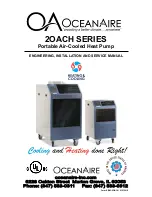
MANUALE D’USO ROUTE - rev. 2 – 10/01
13
WARNING!
Safety risks for personnel mainly arise from improper use or accidental damages.
These risks may be of an electrical nature as far as the non-synchronous motor is
concerned and may cause injury to hands if working on an open pump. Risks may also
arise due to the nature of the liquids pumped. It is therefore of utmost importance to
closely follow all the instructions contained in this manual so as to eliminate the causes
that may lead to pump failure and the consequent leakage of liquid dangerous for both
personnel and the environment.
Risks may also arise from improper maintenance or dismantling practices.
In any case five geeral rules are important:
A - all services must be carried out by specialised personnel or supervised by qualified personnel depending
on the type of maintenance required
B - install protection guards against eventual liquid sprays (when the pump is not installed in remote areas)
due to an accidental pipe rupture. Arrange for safety basins to collect possible leakage
C - when working on the pump always wear acid-proof protective clothing
D - arrange for proper conditions for suction and discharge valve closing during disassembly
E - make sure that the motor is completely disconnected during disassembly.
Proper design and building of the plants, with well positioned and well marked piping fitted with shut-off
valves, adequate passages and work areas for maintenance and inspections are extremely important
(since the pressure developed by the pump could give some kind of damage to the plant in case this one
should be faulty made or wear and tear-damaged).
It must be stressed that the major cause of pump failures leading to a consequent need to intervene is due to
the pump running dry in manually operated plants. This is generally due to:
- the suction valve being open at start-up or
- the suction tank being emptied without stopping
10.1 INSTALLATION AND COMMISSIONING PERSONNEL
Interventions allowed only to specialised personnel who may eventually delegate to others some operations
depending on specific evaluations (technical capability required: specialisation in industrial plumbing or
electric systems as needed).
10.2 OPERATORS AND MAINTENANCE PERSONNEL
Interventions allowed to general operators (after training on the correct use of the plant):
- pump starting and stopping
- opening and closing of valves with the pump at rest
- emptying and washing of the pump body via special valves and piping
- cleaning of filtering elements
Interventions allowed to qualified personnel (technical capacities required: general knowledge of the
mechanical, electrical and chemical features of the plant being fed by the pump and of the pump itself):
- verification of environmental conditions
- verification of the condition of the liquid being pumped
- inspections of the control/stop devices of the pump
- inspections of the rotating parts of the pump
-
trouble shooting
10.3 REPAIR
PERSONNEL
Interventions allowed to general operators under the supervision of qualified personnel:
- stopping of the pump
- closing of the valve
- emptying of pump body
- disconnection of piping from fittings
- removal of anchoring bolts
- washing with water or suitable solvent as needed
- transport (after removal of electrical connections by qualified personnel)
Interventions by qualified personnel (technical capacities required: general knowledge of machining
operations, awareness of possible damage to parts due to abrasion or shocks during handling, know-how
of required bolt and screw tightening required on different materials such as plastics and metals, use of
precision measuring instruments):






































